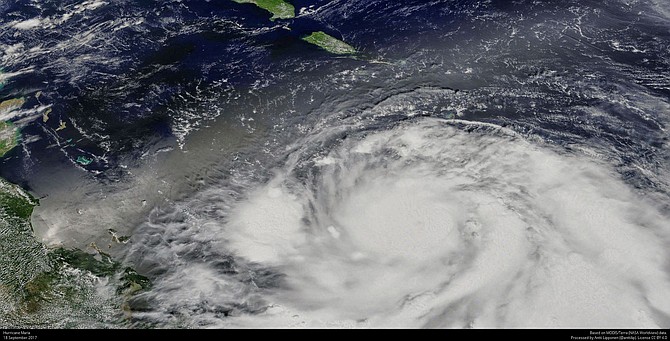Hurricane Maria grew into a Category 3 storm on Monday as it barreled toward a potentially devastating collision with islands in the eastern Caribbean. Forecasters warned it was likely to grow even stronger. Photo courtesy Flickr/Antti Lipponen
SAN JUAN, Puerto Rico (AP) — Hurricane Maria grew into a Category 3 storm on Monday as it barreled toward a potentially devastating collision with islands in the eastern Caribbean. Forecasters warned it was likely to grow even stronger.
The storm was on a path that would take it near many of the islands already wrecked by Hurricane Irma and then on toward a possible direct strike into Puerto Rico on Wednesday as a Category 4 hurricane.
"This storm promises to be catastrophic for our island," said Ernesto Morales with the U.S. National Weather Service in San Juan. "All of Puerto Rico will experience hurricane force winds."
The U.S. territory on Monday imposed rationing of basic supplies including water, milk, baby formula, canned foods, batteries, flashlights and other items.
The U.S. National Hurricane Center said Maria had maximum sustained winds of 125 mph (200 kph) Monday afternoon. It was centered about 45 miles (70 kilometers) east-northeast of Martinique — or 70 miles (115 kilometers) east-southeast of Dominica — and heading west-northwest at 10 mph (17 kph).
Hurricane warnings were posted for the U.S. and British Virgin Islands, Guadeloupe, Dominica, St. Kitts, Nevis, Montserrat, Martinique and St. Lucia. A tropical storm warning was issued for Antigua and Barbuda, Saba, St. Eustatius, St. Maarten and Anguilla.
Forecasters said hurricane conditions should begin to affect parts of the Leeward Islands by late Monday, with storm surge raising water levels by 6 to 9 feet (1.8 to 2.7 meters) near the storm's center. The storm was predicted to bring 6 to 12 inches (15 to 30 centimeters) of rain across the islands, with more in isolated areas.
Officials in Dominica closed schools and government offices on Monday and urged people to evacuate and seek shelters.
"We should not take this storm lightly," said Prime Minister Roosevelt Skerrit. "Let us continue to pray for our safety."
Officials in Guadeloupe said the French Caribbean island of would experience extremely heavy flooding starting Monday afternoon, and they warned that many communities would be submerged overnight.
In nearby Martinique, authorities ordered people to remain indoors and said they should be prepared for power cuts and disruption in the water supply. All schools and non-essential public services were closed.
The storm has hurricane-force winds that extend about 15 miles from the eye, and tropical storm force winds out as far as 120 miles (205 kilometers). The current forecast track would carry it about 22 miles (35 kilometers) south of St. Croix in the U.S. Virgin Islands late Tuesday and early Wednesday, according to territorial Gov. Kenneth Mapp.
"We are going to have a very, very long night," Mapp said as he urged people in the territory to finish any preparations.
St. Thomas and St. John are still recovering from a direct hit by Hurricane Irma, which did extensive damage and caused four deaths on the two islands.
On Wednesday, Maria was expected to be near or over Puerto Rico, which was spared the full brunt of Irma, although much of the island had its power knocked out. Nearly 70,000 people remain without power, and Gov. Ricardo Rossello on Monday warned of another widespread outage.
Forecasters said the storm would dump up to 18 inches (46 centimeters) of rain across Puerto Rico and whip the U.S. territory with heavy winds for 12 to 24 hours.
Officials said the Federal Emergency Management Agency was ready to bring drinking water and help restore power in Puerto Rico immediately after the storm.
Gov. Ricardo Rossello said officials had prepared about 450 shelters with a capacity for nearly 68,000 people — or even 125,000 in an emergency. There are still nearly 200 people in shelters from Hurricane Irma. Schools were cancelled for Monday and government employees would work only a half day.
Farther north, long-lived Hurricane Jose continued to head northward off the U.S. East Coast, causing dangerous surf and rip currents. It wasn't expected to make landfall but tropical storm watches were posted along the coast from Delaware to Massachusetts' Cape Cod.
Jose was centered about 265 miles (425 kilometers) east-southeast of Cape Hatteras, North Carolina, and was moving north at 9 mph (15 kph). It had maximum sustained winds of 75 mph (120 kph).
The ocean washed over parts of North Carolina's Outer Banks as Hurricane Jose passed well to the east, and five people were knocked off a coastal jetty in Rhode Island by high surf caused by the storm. Officials said rescuers had to fight through rough surf to load the injured onto stretchers and get them to shore. All five were taken to a hospital with minor and major injuries.
In the Pacific, Tropical Storm Norma's threat to Mexico's Los Cabos resort area at the southern end of the Baja California Peninsula seemed to ease as forecasters said the storm's center was likely to remain offshore.
Norma had winds of about 50 mph (85 kph) and it was centered about 175 miles (280 kilometers) southwest of Cabo San Lucas. The Baja California Sur state government prepared storm shelters and canceled classes for Monday.
Meanwhile, Tropical Storm Lee weakened into a tropical depression far out in the Atlantic while Hurricane Otis weakened far out in the Pacific. Neither threatened land.
Copyright Associated Press. All rights reserved. This material may not be published, broadcast, rewritten, or redistributed.
More like this story
- Tropical Storm Ernesto Forecast to Strengthen and Continue Towards Gulf
- Ernesto Continues Track Toward Jamaica, 'Florence' Forms in Atlantic
- Ernesto Heads for Jamaica, Mexico
- Tropical Depression in Atlantic Threatens Caribbean, Expected to Strengthen
- As Irma Spins, Cuba Evacuates; Floridians Empty Stores



Comments
Use the comment form below to begin a discussion about this content.
comments powered by Disqus